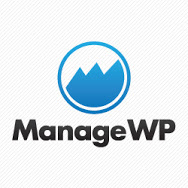Are you looking for the best website monitoring tools to keep you informed about your uptime, and other performance metrics?
When your website breaks, it costs you money and frustrates your visitors.
You need to know as soon as problems occur so you can take action and get things working again.
In this post, we’ve rounded up the best website monitoring tools to keep you informed about the state of your website.
Ready? Let’s get started:
The best website monitoring services to check uptime and more
Here are our top three options if you’re pressed for time:
- StatusCake – Best dedicated website monitoring tool with uptime monitoring and more.
- Hexometer – Best for those who need to go beyond traditional uptime and website monitoring. Monitor issues related to UX, SEO, broken links, and more.
- Monitive – Offers great balance of simplicity and functionality of any website monitoring service. Best for real-time alerts.
#1 – StatusCake
StatusCake is an all-around website monitoring tool with a customer base of over 120,000 customers, some of whom include Mailchimp, Microsoft, Harvard University and video game giant EA.

You can set up between 10 and 300 monitors with StatusCake. Five points of data make up its monitoring suite. Most important are the uptime and page speed monitoring tools.
Uptime checks are done every five minutes, one minute or 30 seconds depending on your plan, from over 40 locations in 30 countries. Page speed tests are conducted in 24-hour, 15-minute or five-minute intervals depending on your plan. You’re also allowed between one and 30 monitors for this type of monitoring.
The page speed test will also generate a report detailing performance issues with your site and what you can do to improve them.
The service will also monitor your server to pinpoint errors that may lead to downtime as well as let you know how long you have until your domain and SSL certificate expire.
You can also create status pages, though this is an extra feature.
Pricing: A limited free plan is available. Premium plans start at $24.49/month or $244.92/year (advertised as $20.41/month).
#2 – Hexometer
Hexometer is another all-around website monitoring tool similar to StatusCake but with a feature-set that goes beyond traditional website monitoring and performance monitoring.
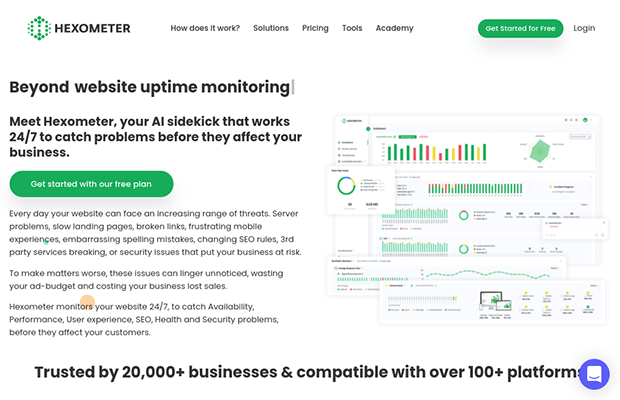
It allows you to monitor up to five websites that have as many as 50,000 pages each, depending on your plan. Uptime checks are done every five minutes or one minute. Uptime monitoring can be done by hostname as well, so you can monitor uptime for your email server, DNS, CDN, SMTP, POP3 and more.
The tool also has a page speed checker that helps you keep an eye on your site’s performance and will suggest changes you can make to improve it.
Hexometer’s domain and SSL certificate tools allow you to look up any website, not just your own, to see who owns it and when the certificates will expire.
The tool also has a broken link checker, an SEO meta tag scanner, a page asset analyzer, and a stack checker you can deploy to see the server set up, CMS and more of any website.
Pricing: A limited free forever plan is available. Premium plans start at $12/month or $120/year (advertised as $10/month).
#3 – Monitive
Monitive is a simple but powerful HTTP-monitoring tool with a that includes The New York Times and WikiHow. Checks are performed at over 20 worldwide locations.
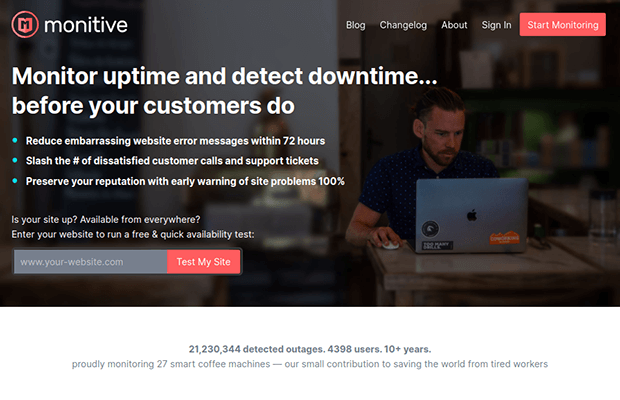
It allows you to monitor server uptime performance and broken links by monitoring individual pages. The free plan monitors one page while the premium plan monitors up to 500.
Its alerts are simple. You’ll get an email alert the second your site goes down. You’ll receive an SMS message if your site is down for more than three minutes. The service sends out a phone call if your site goes down for more than 10 minutes. All of these alerts are configurable.
You can also customize how often the tool checks your server, from every one minute to every 24 hours.
Technical users have access to a variety of specific monitors and configurable settings. This includes ping monitoring for internet devices and hosts, TCP port monitoring, alerts for when a page you’re monitoring no longer contains a configured keyword, and more.
Status pages are also available.
Pricing: Monitive has a free forever plan and a $7/month plan.
Learn more in our Monitive review.
#4 – Site24x7
Site24x7 is a bit of a technical website monitoring tool, though you can input your site’s URL and start an uptime monitor if that’s all you want to do.
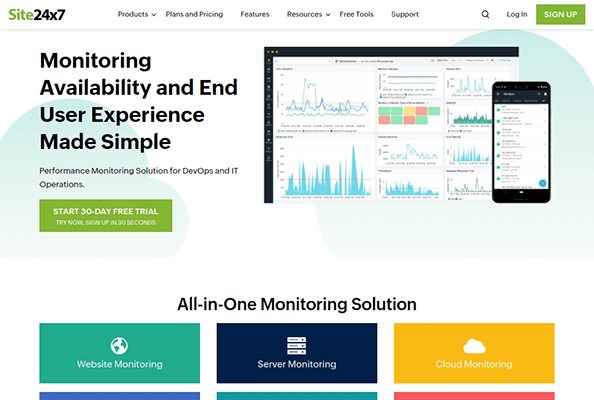
You can monitor up to 100 websites and servers, depending on your plan. You have up to eight locations you can monitor from with over 110 worldwide locations to choose from. Along with websites, you can monitor DNS, FTP and SMTP.
The tool also has a page speed checker that can also analyze how long it takes to load images, videos, JavaScript, documents and other assets.
For security, Site24x7 can detect unauthorized changes in regards to iframe and other script injections, content modifications, and more. The tool can also keep an eye on when your domain and SSL certificate expire. There’s even access to popular blocklists you can use to add IP addresses to your own security tool’s blocklist and a brand reputation tool that identifies infected or malicious URLs on your site.
You can also set up status pages.
Pricing: Site24x7’s website monitoring plans start at $120/year (advertised as $10/month).
#5 – Dotcom-Monitor
Dotcom-Monitor is an all-in-one monitoring tool with a wide customer base that includes such names as Dell, Comcast, Xerox, Volvo, Dish and Citrix.
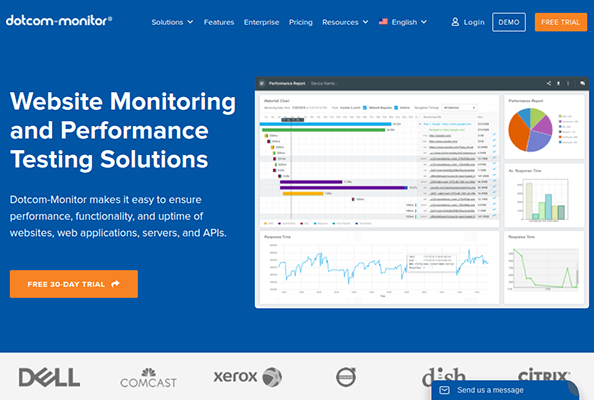
Dotcom-Monitor can monitor the performance of your site, server and web applications from over 25 locations around the world. Checks are performed in five or one-minute intervals, depending on the plan you choose.
This service is another monitoring tool ideal for developers and advanced users as it has a lot of technical monitors and settings. The tool can monitor SOAP, REST, JSON and XML web services as well as OAuth-based web APIs.
SSL certificate and WebSocket monitoring is included as well.
Alerts are entirely configurable. You can receive them by email, SMS message, voice message, Slack channel and more as individual or group alerts.
Pricing: Dotcom-Monitor’s services have their own pricing structures. Pricing for the performance and uptime monitoring service starts costs $19.95/month for five-minute checks and $39.98/month for one-minute checks.
#6 – UptimeRobot
UptimeRobot is a fantastic free option if all you need is a reliable uptime monitor. It has a user base of over 1.5 million that includes such names as NASA, GoDaddy, IBM and Expedia.
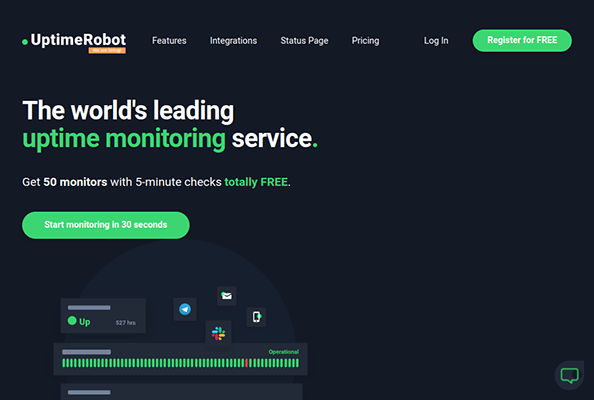
You run up to 50 monitors on the free plan and up to 10,000 on the premium plan, though the cost of the premium plan goes up depending on the number of monitors you need.
Checks are done in five or one-minute intervals depending on the plan you have. Alerts are sent via email in the free plan, but SMS and voice messages are available in the premium version. You can even set up maintenance windows to prevent alerts during scheduled downtime.
SSL certificate monitoring and status pages are available as well.
Pricing: UptimeRobot has a generous free forever plan that allows you to set up 50 monitors. Premium plans start at $18/month or $180/year (advertised as $15/month).
#7 – Pingdom
Pingdom is well-known for its free page speed tool, but that tool is really part of a larger website monitoring service.
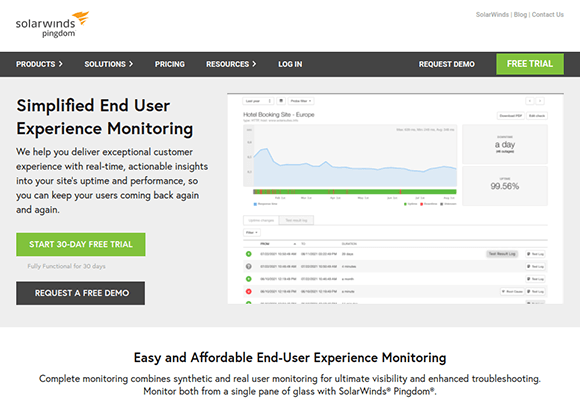
Most of Pingdom’s tools are divided into two separate services: synthetic monitoring and real-user monitoring. Synthetic monitoring includes uptime, page speed and transaction monitoring.
The uptime monitor can be configured to perform a check every one minute to every hour. Pingdom also performs its checks from over 100 worldwide locations. Alerts are also configurable as well and are sent via email and SMS.
Status pages are included as well.
Pingdom’s premium page speed tool runs performance checks on your site over time and provides suggestions on how to improve an individual page’s overall performance.
Pricing: Pingdom’s synthetic monitoring and real-user monitoring tools are priced as two separate services. Both start at $15/month or $120/year (advertised as $10/month) for 10 monitors.
#8 – Uptrends
Uptrends is a website monitoring service used by over 30,000 businesses worldwide, including Vimeo, Zendesk, Virgin and SpaceX.
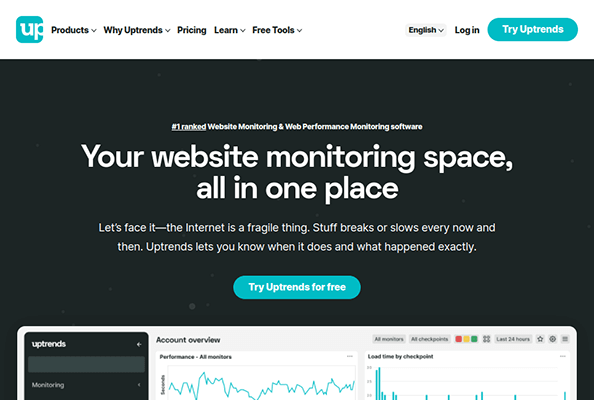
The service has a free uptime tool you can use to test your website’s availability at 227 checkpoints around the world. The premium version comes with uptime monitoring you can configure to perform checks every one to 60 minutes.
Like Pingdom, Uptrends also has a free page speed tool, though the premium version runs continuous checks to see how your website performs across worldwide locations. Detailed performance reports help you pinpoint areas you can improve on.
Pricing: Uptrends has free yet limited uptime and website monitoring tools. Premium plans start at $17.19/month or $185.64/year (advertised as $15.47/month).
#9 – New Relic
New Relic is not a simple website monitoring service nor is it even a simple tool to use. It’s best suited for large ecommerce sites and web applications as it helps developers sift through countless lines of code and server stacks in search of errors.
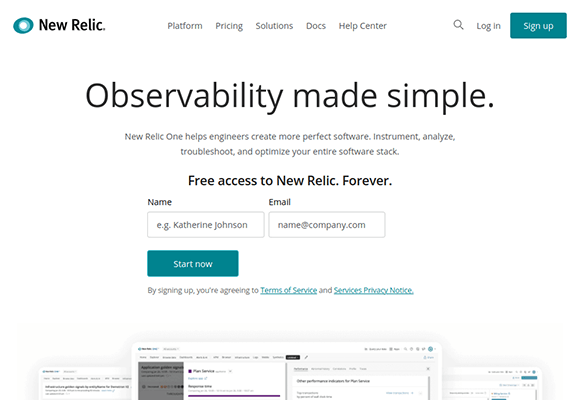
Alerts are configurable and integratable with communication tools popular among dev teams, including Slack, PagerDuty, Campfire and HipChat.
The tool is especially optimized for sites and applications built on servers powered by AWS, Google Cloud Platform, Microsoft Azure and Pivotal Cloud Foundry.
Pricing: New Relic is free for up to 100GB/month and 1,000 incident events. After that, the service costs $99/month per additional user plus $0.25/GB and $0.50 per incident event.
#10 – Sematext
Sematext is an advanced all-in-one monitoring service designed to help DevOps teams monitor entire IT systems. Its customer base includes eBay, Instagram and Etsy.
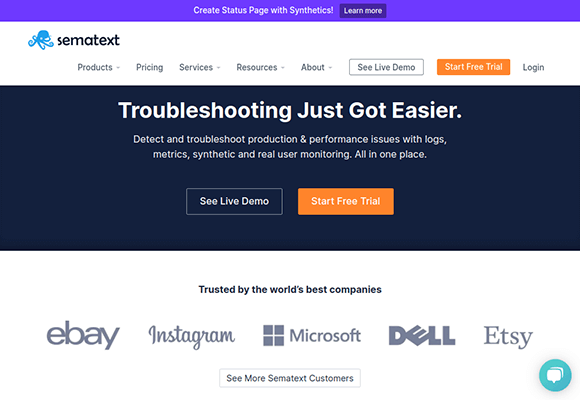
It offers monitoring for application performance, logs, servers, containers, processes, databases, networks, uptime, websites, APIs, JVMs and inventories.
Like New Relic, its technical monitoring tools enable development teams to receive alerts about code-related and server errors across their entire stack, not just a web page.
Alerts integrate with Slack, PagerDuty, email, mobile push notifications and more.
The tool’s server monitoring is even compatible with AWS, Microsoft Azure, Google Cloud Platform, DigitalOcean, IBM Cloud and more.
Pricing: Free plans are available for all services. Pricing for premium infrastructure monitoring starts at $0.007/container host per hour. Pricing for premium integration monitoring starts at $0.035/agent per hour.
Choosing the best website monitoring tool
The website monitoring services on this list vary by what they monitor as well as how simple or complex they are. If all you’re looking for is a simple uptime monitoring tool with a few perks, check out our top three options StatusCake, Hexometer, and Monitive.
The term “website monitoring” incorporates numerous checks that determine how well your users are able to reach and interact with your website. This primarily involves uptime monitoring to determine whether or not your website is accessible to users in places all over the world.
The time your website spends offline or inaccessible is called “downtime.” Uptime performance is measured by how long your website remains accessible. For instance, an uptime performance of 99.9% means your website has been up 99.9% and down 0.1% of the time over a given timeframe.
There’s also page speed monitoring that keeps an eye on performance issues related to your site and provides suggestions on how to improve its overall performance.
Some tools offer server monitoring. This allows you to monitor usage metrics for your server’s CPU, RAM, disk, network and more. The main advantage of this type of monitoring is your ability to plan ahead in terms of server capacity. You can upgrade to a larger server before you reach your current server’s limit.
API monitoring can pinpoint issues with your application’s API, the third-party APIs you use on your site or both depending on the service you choose.
It’s best to determine the type of website you have (small blog, membership site, large ecommerce store, etc.), how technically-inclined you are and your budget to narrow down your options and decide on a tool. These factors will help you determine which is the best website monitoring tool for your website.
Which of the website monitoring services above will you choose?
Disclosure: This post contains affiliate links. This means we may make a small commission if you make a purchase.



